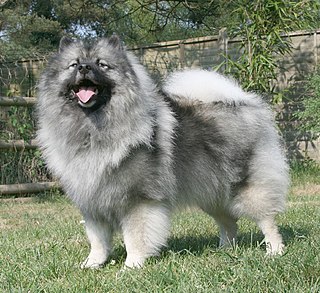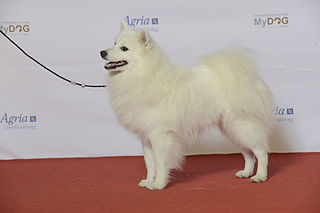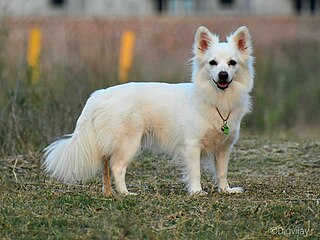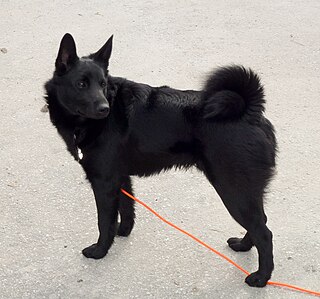
The Keeshond is a medium-sized dog with a plush, two-layer coat of silver and black fur with a ruff and a curled tail. The Keeshond is descended from ancient Arctic dogs. Their closest relatives are the German spitzes such as the Großspitz, Mittelspitz, Kleinspitz, Zwergspitz (Dwarf-Spitz) or Pomeranian.

The Shiba Inu is a breed of hunting dog from Japan. A small-to-medium breed, it is the smallest of the six original breed of dogs native to Japan. Its name literally translates to "brushwood dog", as it is used to flush game.

The Pomeranian dog, or simply Pomeranian, is a breed of dog of the Spitz type that is named for the Pomerania region in north-west Poland and north-east Germany in Central Europe. Classed as a toy dog breed because of its small size, the Pomeranian is descended from larger Spitz-type dogs, specifically the German Spitz.

The Hungarian Vizsla is a dog breed from Hungary and belongs to the Federation Cynologique Internationale (FCI) group 7, the Canadian Kennel Club (CKC) group 1, and the American Kennel Club. The Hungarian or Magyar Vizsla or Smooth-Haired Vizsla are sporting dogs and loyal companions. The Vizsla's medium size is one of the breed's most appealing characteristics. As a hunter of fowl and upland game, the Vizsla has held a prominent position among sporting dogs – that of household companion and family dog.

The Swedish Vallhund, also known as the Västgötaspets and Swedish cow dog, is a breed of dog native to Sweden. The breed's name, Vallhund, when translated into English, means herding dog, as the Swedish Vallhund was originally bred as a drover and herder of cows over 1,000 years ago. In 1942, the dog came close to extinction, but careful breeding and publicity by Swedish national Björn von Rosen and K. G. Zettersten managed to revive the breed in popularity and save it from its likely end. In 1943, the Swedish Kennel Club recognized the Swedish Vallhund as a breed, and officially categorized the Swedish Vallhund as "the Västgötaspets" for Västergötland, the province in which their revival took place. Since then, the breed has been recognized by, and bred in, over ten countries and has gained some popularity.

The Alaskan Malamute is a large breed of dog that was originally bred for its strength and endurance, to haul heavy freight as a sled dog, and as a hound. It is similar to other arctic breeds such as the husky, the spitz, the Greenland Dog, Canadian Eskimo Dog, the Siberian Husky, and the Samoyed.

The Weimaraner is a large dog that was originally bred as a hunting dog in the early 19th century. Early Weimaraners were used by royalty for hunting large game such as boar, bear, and deer. As the popularity of hunting large game began to decline, Weimaraners were used for hunting smaller animals like fowl, rabbits, and foxes.

The Karelian Bear Dog is a Finnish breed of dog. In its home country, it is seen by many as a national treasure. Karelian Bear Dogs will hunt a variety of animals. Its quick reflexes and fearless nature have made it very popular for hunting large game including brown bears, moose, and wild boar. It was the breed's ability to hunt bears that earned the breed its name. The Karelian Bear Dog is among the top 10 most common dog breeds in Finland.

The Japanese Spitz is a small to medium breed of dog of the Spitz type. There are varying standards around the world as to the ideal size of the breed, but they are always larger than their smaller cousins, the Pomeranian. They were developed in Japan in the 1920s and 1930s by breeding a number of other Spitz type dog breeds together. They are recognized by the vast majority of the major kennel clubs, except the American Kennel Club due to it being of similar appearance to the white Pomeranian, American Eskimo Dog and Samoyed. While they are a relatively new breed, they are becoming widely popular due to their favorable temperament and other features.

The Eurasier, or Eurasian, is a spitz type breed of dog that originated in Germany through cross-breeding between popular European and Asian Spitz. It is widely known as a wonderful companion that maintains its own personality, has a dignified reserve with strangers, has a strong bond to its family, and is relatively easy to train.

The Finnish Lapphund is a hardy, easy going, medium-size breed of Spitz type. Traditionally it has been used for herding reindeer. Although it is one of the most popular dog breeds in its native country, Finland, it is not very numerous outside of the Nordic countries.

The Norrbottenspets, also known as the Norrbottenspitz, the Nordic Spitz and the Pohjanpystykorva, is a breed of spitz type dog from Sweden. A small- to medium-sized breed with typical spitz-like features, the Norrbottenspets has traditionally been kept as a hunting dog in Northern Sweden and is closely related to similar Nordic spitz breeds such as the Finnish Spitz.

The Indian Spitz is a spitz dog breed belonging to the utility group. The Indian Spitz was one of the most popular dogs in India in the 1980s and 1990s when India's import rules made it difficult to import dogs of other breeds.

The West Siberian Laika or WSL, is a breed of spitz–type hunting dog. Russian publications indicate that the term West Siberian Laika loosely applied to hunting dogs originating with the Mansi and Khanty people in Ural and West Siberia, but there were no standards or registrations of WSL as such until 1930. Then WWII disrupted it for a while, but systematic breeding with registrations resumed after the war ended, in 1946. This was the time the breed began taking modern shape. Before that hunters only knew of Mansi Laika and Khanty Laika. In early 1960 many hunters in Ural still preferred the term Mansi Laika, when speaking of West Siberian Laika. In Russian language, the term Laika originated from the word layat that means to bark. The word Laika simply means barker. Any hunting Laika is a bark pointer. It is a versatile dog depending on use and environment, but in certain parts of the country they have become more specialized.

Smaland Hound is a breed of dog that originated in Sweden in the 16th century. Thought to be the oldest scent hound breed native to Sweden, it was first recognized by the Swedish Kennel Club in 1921. They are the smallest of the Swedish hound breeds, and have black and tan markings similar to the rottweiler. Internationally, it is recognized by a number of kennel clubs and registries including the Fédération Cynologique Internationale and United Kennel Club. It is considered rare, even in its native Sweden where only around sixty puppies are registered each year.

The Black Norwegian Elkhound is a small Spitz breed classified by the FCI as a hunting dog. It is currently an uncommon breed in Norway and very rare outside the Nordic countries of Scandinavia. It is a sibling breed to a Grey Norwegian Elkhound, but is smaller, more agile, doesn't bark and was bred explicitly for on-leash dog hunting.

The Hungarian Wirehaired Vizsla is the English name of the Drótszőrű Magyar Vizsla, a dog breed originating in Hungary, with the name translating directly as Hungarian wirehaired pointer. The English plural is vizslas or sometimes vizslak, based on the Hungarian plural vizslák ).

Podenco Canario is a breed of dog from the Canary Islands. The Podenco Canario is still used today, primarily in packs, most often for the sport hunting of rabbits. The word "podenco" in Spain refers to a certain type of dog, typically rabbit hunters with the same body shape. "Canario" is a reference to its region of origin, the Canary Islands. The Spanish Kennel Club, Real Sociedad Canina de España, recognises the following similar dog breeds that use the identifier "podenco" in their names: Podenco Andaluz, Podenco Ibicenco, and Podenco Valenciano. ge

The Karelo-Finnish Laika is a breed of spitz-type dog from the Karelia area of Russia.

The Bohemian Spotted Dog is a medium-sized dog breed. Originally bred for laboratory purposes by František Horák in Prague in the 1950s, the breed is now primarily a companion dog. This breed is recognized by the Czech Kennel Club but is not FCI recognized.






















